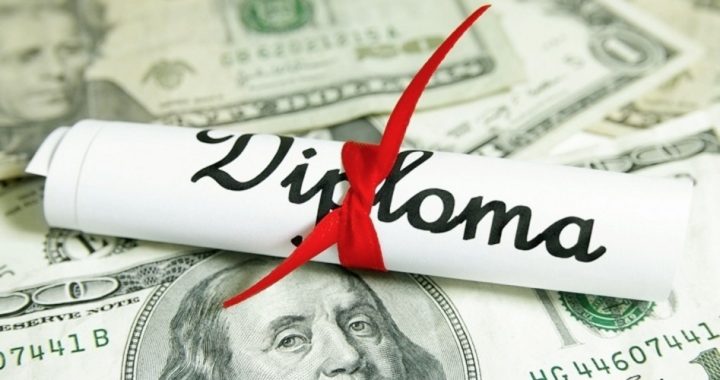
The student loan debt crisis is looming larger than ever. According to a new report by the Department of Education, default rates on student loan debt have soared to 13.4 percent during the first three years of the debt repayment. More than one in 10 borrowers have already defaulted on student loan repayments, and the crisis is just getting underway. With the total amount of student loan debt surpassing $1 trillion (and exceeding total credit card debt) for the first time ever earlier this year, indications are that, absent a quick and vigorous economic recovery, unemployed or underemployed college graduates tens of thousands of dollars in debt will continue to default at an accelerating rate.
Perhaps surprisingly, the default rate is highest among graduates of for-profit institutions like the University of Phoenix. Graduates of such universities are now defaulting at the extraordinary rate of 22.7 percent, or nearly a quarter of all graduates. Some for-profits are now being accused of encouraging students to defer loan repayment until well after graduation, to keep down “official” default rates (i.e., those occurring within the three-year window) and ensure that the schools’ federal funding is not jeopardized.
Students graduating from public institutions are defaulting at the more moderate rate of 11 percent, while graduates from private non-profit schools are defaulting at 7.5 percent.
A large part of the problem is the soaring cost of a college education, yet another bubble created by government policy. With cheap, easy credit available, colleges and universities have had every incentive to push up costs astronomically over the last several decades, paying scant heed to competitive pricing because they have been secure in the knowledge that students flush with loan monies will continue to flock to their doors.
Until now. With annual tuition rates alone well into five figures even for traditionally bargain-basement institutions like land-grant universities, potential students and their hard-pressed parents are very likely to start looking for alternatives to baccalaureate degrees. Although college enrollments remain steady so far, so did housing purchases — right up to the eve of the crash.
Student loan debt is different from credit card debt and mortgage debt in one very significant way: It cannot be discharged via bankruptcy. Student debt, under current law, is with the borrower, interest accrual and all, for as long as it takes to pay it off, unless extreme circumstances like total disability supervene. Creditors almost never forgive student debt, because they know that, backed by the federal government, they can continue to pile on interest and pursue delinquent borrowers literally for their entire lives.
In better times, few student borrowers were even aware of such obligations. But with defaults on the rise, aggressive and less-than-fully-truthful tactics employed by lenders to entice students to borrow money on what seem like attractive terms are now getting wide publicity — as are banks’ increasingly aggressive efforts to track down and shake down borrowers in default.
This author, who has the good fortune to be free of student loan debt, has had some personal experience with such tactics. When I borrowed a low five-figure sum to help pay for an MA program 20 years ago, I was told that payments would be automatically deferred for up to six months after I finished school, and that as long as I stayed in grad school, I would not be required to pay. (I took out the loan before I came to understand that student loans, like so much of what the federal government does, are unconstitutional).
I moved directly from my MA program to a PhD program at another institution. About a year into my PhD program, I began receiving communications from a debt collector indicating that I was in default. I informed that individual that I was in a PhD program, and that I had been given to understand that I was under no obligation to start repayment until I graduated. He reluctantly agreed, but still tried to talk me into making a payment. Fortunately for me, the matter ended there.
Several years later, while still in my PhD program, I managed, thanks to some fortuitous investments in the dotcom bubble using a little seed money from a generous grandparent, I accumulated enough in stocks to enable me to pay off the loan at one shot. When I called the lender, I explained that I wished to pay off the entire loan immediately. When he asked whether I was still in school, I told him that I was. He then tried to dissuade me from paying off the loans, explaining that it would be much wiser financially to make the payments over a 10-year term and hold onto my money. I replied to the effect that I had no intention of being in debt to the government any longer than absolutely necessary, and that I wanted to repay immediately. He reluctantly agreed to send me forms to make that possible (such forms not being easily available), and that was that.
In other words, the entire system has been devised to discourage swift payoffs and to crack down hard on anybody late on payments. While I have had no experience with the college-loan cartel since I mailed in my loan repayment, in full, around 14 years ago, I can only imagine how much more the system is jerry-rigged today to suck in gullible young borrowers — who will never enjoy the windfalls associated with a dotcom bubble — and then squeeze them by any means necessary once they are obligated to repay. Inasmuch as student borrowers are uniquely required by law to repay under any circumstances, the student loan business is the closest thing — so far — to debtor prison in modern society.
The best remedy for the burgeoning student loan crisis is to phase out federal loans and loan subsidies (which would eliminate the artificially easy credit conditions) and to reform laws associated with student loans to make them dischargeable by bankruptcy proceedings to the same degree as other forms of unsecured debt. This would guarantee that student loans would become harder to get, probably (as is already the case with mortgages and car loans, e.g.) encouraging banks to require cosigners with assets to secure the loan, and driving up interest rates to something approaching fair market value. But it would also drive down the cost of higher education as colleges and universities rediscover the need to price their products competitively.
Until such steps are taken, expect the student debt crisis to worsen.
Photo closeup of a mini diploma on cash via Shutterstock



